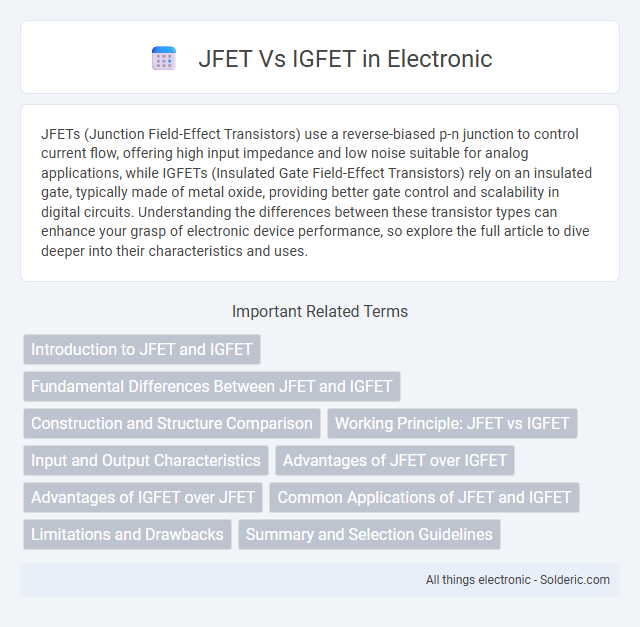JFETs (Junction Field-Effect Transistors) use a reverse-biased p-n junction to control current flow, offering high input impedance and low noise suitable for analog applications, while IGFETs (Insulated Gate Field-Effect Transistors) rely on an insulated gate, typically made of metal oxide, providing better gate control and scalability in digital circuits. Understanding the differences between these transistor types can enhance your grasp of electronic device performance, so explore the full article to dive deeper into their characteristics and uses.
Comparison Table
| Feature | JFET (Junction Field Effect Transistor) | IGFET (Insulated Gate Field Effect Transistor) / MOSFET |
|---|---|---|
| Gate Structure | PN junction gate | Insulated gate (oxide layer) |
| Gate Current | Very low (reverse-biased junction) | Negligible (insulated gate) |
| Control Mechanism | Voltage controls channel depletion | Voltage controls channel conductivity via capacitance |
| Input Impedance | High (10^9 to 10^12 ohms) | Extremely high (10^12 to 10^15 ohms) |
| Mode of Operation | Normally ON (depletion mode) | Depletion and Enhancement modes available |
| Manufacturing Complexity | Simple | More complex, requires oxide isolation |
| Switching Speed | Slower | Faster switching capability |
| Applications | Low-noise amplifiers, analog switches | Digital circuits, power electronics, amplifiers |
Introduction to JFET and IGFET
JFET (Junction Field-Effect Transistor) operates by controlling current through a reverse-biased p-n junction, utilizing voltage applied to the gate to modulate channel conductivity in semiconductor materials. IGFET (Insulated Gate Field-Effect Transistor), commonly known as MOSFET, uses an insulated gate electrode separated from the channel by a thin oxide layer, enabling enhanced control of current flow with minimal gate current. Both transistors serve as voltage-controlled devices used in amplification and switching, with JFET offering low noise and IGFET providing high input impedance and scalability in integrated circuits.
Fundamental Differences Between JFET and IGFET
JFET (Junction Field-Effect Transistor) uses a reverse-biased p-n junction to control current flow, while IGFET (Insulated Gate Field-Effect Transistor) relies on an insulated gate oxide layer to modulate channel conductivity. Unlike JFET's voltage-controlled depletion mode operation, IGFET operates primarily in enhancement mode, requiring a positive gate voltage for conduction. Your choice between these devices depends on factors like power efficiency, switching speed, and noise characteristics inherent to their fundamental structural differences.
Construction and Structure Comparison
JFETs (Junction Field-Effect Transistors) feature a channel of semiconductor material with a p-n junction that controls current flow, utilizing a reverse-biased gate junction to modulate conductivity. IGFETs (Insulated-Gate Field-Effect Transistors), commonly known as MOSFETs, incorporate a metal-oxide-semiconductor structure with an insulating oxide layer between the gate terminal and the semiconductor channel, enabling voltage control without direct gate current. This fundamental difference in gate insulation and junction presence leads to distinct electrical characteristics and fabrication complexities between JFETs and IGFETs.
Working Principle: JFET vs IGFET
JFET (Junction Field-Effect Transistor) operates by controlling current through a semiconductor channel using a reverse-biased PN junction, which modulates the channel width via depletion region expansion. IGFET (Insulated-Gate Field-Effect Transistor), commonly known as MOSFET, uses an insulated gate electrode to induce a conductive channel through an electric field without direct current flow into the gate. Understanding the difference in working principles helps you select the appropriate transistor for low-power or high-impedance applications.
Input and Output Characteristics
JFETs (Junction Field-Effect Transistors) exhibit high input impedance due to their reverse-biased PN junction gate, resulting in minimal gate current and stable input characteristics. IGFETs (Insulated Gate Field-Effect Transistors), such as MOSFETs, possess extremely high input impedance because of the insulated gate, effectively eliminating gate current and enhancing voltage control efficiency. In output characteristics, JFETs show a saturating drain current controlled by gate-to-source voltage, while IGFETs provide greater scalability and higher transconductance, enabling improved switching speed and output linearity in integrated circuits.
Advantages of JFET over IGFET
JFETs (Junction Field-Effect Transistors) offer advantages such as lower noise generation and simpler fabrication compared to IGFETs (Insulated-Gate Field-Effect Transistors), making them ideal for low-noise analog applications. Their inherently higher input impedance and absence of an oxide layer reduce electron trapping, enhancing reliability in harsh environments. Your circuit design benefits from JFETs' robustness and consistent performance under varying temperature and voltage conditions.
Advantages of IGFET over JFET
IGFETs (Insulated Gate Field Effect Transistors) offer superior input impedance compared to JFETs, resulting in minimal gate current and enhanced signal integrity. Their insulated gate structure provides better voltage control and reduced power consumption, making them ideal for low-power applications. You benefit from greater scalability and integration flexibility in complex circuits when choosing IGFET devices over JFETs.
Common Applications of JFET and IGFET
JFETs are commonly used in low-noise amplifiers, analog switches, and buffer amplifiers due to their high input impedance and low noise characteristics. IGFETs, also known as MOSFETs, dominate digital integrated circuits, power switching applications, and high-speed amplifier designs because of their scalability and efficient gate control. Both technologies serve critical roles in analog and digital electronics, with JFETs favored for signal integrity and IGFETs preferred for integration density and power efficiency.
Limitations and Drawbacks
JFETs suffer from higher gate leakage current and lower input impedance compared to IGFETs, limiting their effectiveness in high-frequency applications. IGFETs, or MOSFETs, experience threshold voltage variability and require careful control of oxide thickness, which can lead to reduced device reliability and increased short-channel effects in nanometer-scale fabrication. Both devices face challenges in scaling, but IGFETs dominate due to better gate control and lower power consumption despite these drawbacks.
Summary and Selection Guidelines
JFETs (Junction Field Effect Transistors) offer low noise and high input impedance, making them ideal for analog signal amplification, while IGFETs (Insulated Gate FETs), commonly known as MOSFETs, provide superior switching speed and higher input impedance suited for digital and power applications. Select JFETs for low-noise, low-frequency analog circuits where gate leakage must be minimized, and choose IGFETs for high-speed switching, high-density integration, and low power consumption in digital circuits. Consider device fabrication complexity, threshold voltage, and application-specific requirements when deciding between JFET and IGFET technologies.
JFET vs IGFET Infographic

 solderic.com
solderic.com